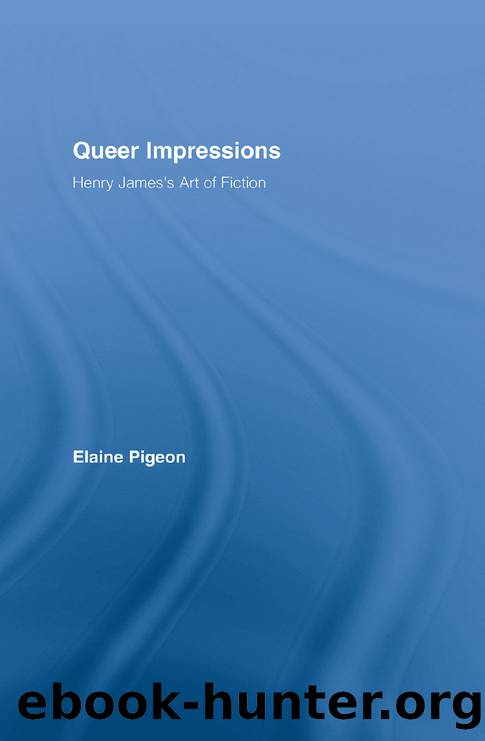Queer Impressions by Pigeon Elaine;

Author:Pigeon, Elaine;
Language: eng
Format: epub
Publisher: Taylor & Francis Group
Published: 2005-08-15T00:00:00+00:00
Of course, the back is significant, as Madame Merle provides a dramatic turning point in Isabelâs life.
The next painting by Degas, Café Singer, focuses on a singer at the café-concert caught in mid-performance. We see her in close-up, from the bust up, standing right of centre, with her mouth open and her head tilted slightly upward as she belts out her song with her right hand dramatically raised and covered by a long, very black glove, so that her upward gesture dominates the picture. One may also recall that James emphasizes Madame Merleâs hands; in fact, he describes her as if she were a classical statue: Madame Merle, he writes, âhad thick, fair hair, arranged somehow âclassicallyâ and as if she were a Bust, Isabel judged-a Juno or a Niobe, and large white hands, of a perfect shape, a shape so perfect that their possessor, preferring to leave them unadorned, wore no jewelled ringsâ (228). Obviously James did not draw attention to Madame Merleâs hands in order to suggest the kind of work she performed; rather, in describing them as large, he may very well have been suggesting her ability to manipulate people.
Whereas these two examples alone may not be entirely convincing, the third bears an uncanny resemblance to the example James provides in âThe Art of Fictionâ to illustrate what he means by an impression. âA man opens a door,â Duranty writes, âhe enters, and that is enough: we see that he has lost his daughter!â (44). According to James, his example was provided by an English novelist, âa woman of genius,â who was concerned with presenting an accurate impression of a âFrench Protestant youthâ (194). While living in Paris, James relates, she once
passed an open door where, in the household of a Pasteur, some of the young Protestants were seated at table round a finished meal. The glimpse made a picture.⦠She had got her direct personal impression, and she turned out her type. She knew what youth was, and what Protestantism; she also had the advantage of having seen what it was to be French, so that she converted these ideas into a concrete image and produced a reality. (194)
Download
This site does not store any files on its server. We only index and link to content provided by other sites. Please contact the content providers to delete copyright contents if any and email us, we'll remove relevant links or contents immediately.
4 3 2 1: A Novel by Paul Auster(11791)
The handmaid's tale by Margaret Atwood(7450)
Giovanni's Room by James Baldwin(6810)
Asking the Right Questions: A Guide to Critical Thinking by M. Neil Browne & Stuart M. Keeley(5357)
Big Magic: Creative Living Beyond Fear by Elizabeth Gilbert(5353)
Ego Is the Enemy by Ryan Holiday(4958)
On Writing A Memoir of the Craft by Stephen King(4664)
The Body: A Guide for Occupants by Bill Bryson(4584)
Ken Follett - World without end by Ken Follett(4444)
Bluets by Maggie Nelson(4261)
Adulting by Kelly Williams Brown(4235)
Eat That Frog! by Brian Tracy(4149)
Guilty Pleasures by Laurell K Hamilton(4118)
White Noise - A Novel by Don DeLillo(3829)
The Poetry of Pablo Neruda by Pablo Neruda(3816)
Fingerprints of the Gods by Graham Hancock(3738)
Alive: The Story of the Andes Survivors by Piers Paul Read(3731)
The Book of Joy by Dalai Lama(3698)
The Bookshop by Penelope Fitzgerald(3619)
